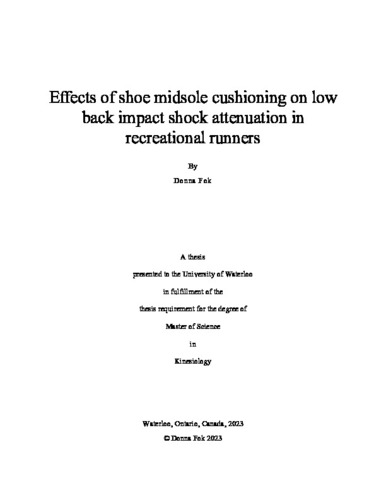| dc.description.abstract | Running is one of the most widely practiced and accessible forms of physical activity. When the foot contacts the ground during running, impacts on the order of two to three times body weight are generated. The impact force is attenuated by joints and propagated through each subsequent segment from the foot to the head over 600 times per kilometer and has been associated with the development of various pains and injuries across runners. Consequently, mechanisms of shock attenuation have been widely researched across the last few decades, where previous work has aimed to examine how joint positioning, eccentric muscle activation, passive soft tissue structures, and other strategies may help mitigate this impact on the musculoskeletal system. However, how these mechanisms are presented in the lumbar spine, which largely influence the delivery and experience of this impact shock in the upper body and head, is not well understood.
Further complicating this area is the role of running shoe cushioning, or the midsole. Softer and thicker midsoles have been shown to interact with lower limb kinematics and muscle activation, contributing to differences in leg stiffness and shock attenuation. Therefore, it was hypothesized that more compliant midsoles would produce similar results in the lumbar spine. Specifically, the purpose of this study was to investigate if increased shock transmission and shock attenuation occurred in the lumbar spine in response to softer midsoles. It was further hypothesized that differences would exist in sagittal knee and lumbar flexion angles and trunk muscle activation across midsole cushioning stiffness as well as between sex.
Twenty (10M, 10F) pain-free recreational runners who averaged a minimum weekly mileage of 16 km were recruited to participate in this study. Subjects were asked to run on a treadmill at 3.3 m/s for five minutes in each of three shoe conditions that ranged in their midsole cushioning stiffness, quantified prior to use in running via a mechanical testing system. Sagittal kinematics of the lumbar spine, pelvis, and right lower limb were collected using an active motion capture system, mean bilateral muscle activity, co-activation indices, and phase lags between co-activation of the lumbar erector spinae, rectus abdominus, and external obliques were measured via surface electromyography, and accelerometers were placed at the distal tibia, borders of the lumbar spine, and head to calculate peak resultant acceleration as well as shock attenuation in the frequency domain. All variables were calculated during stance phase and averaged across fifteen consecutive strides. Two-way mixed measures analyses of variances were used to assess differences across shoe conditions and between sexes.
Softer and more compliant midsoles resulted in increased ankle plantarflexion and knee extension leading to differences in low frequency shock attenuation, but the low back was not particularly responsive to midsole stiffness. Similar tibial and lumbar spine acceleration magnitudes were observed across all midsole stiffness conditions, and neither lumbar posture nor trunk muscle activation and co-activation changed with footwear. Minor differences were observed between sex, suggesting that females may employ slightly different shock attenuation mechanisms particularly at the hips and lower limbs, but future investigations are necessary to better understand the specific shock attenuation mechanisms involved. Overall, these results add to the evidence that midsole cushioning stiffness may influence the lower limb but suggest that such changes are accommodated by the time the shock reaches the lumbar spine. | en |

